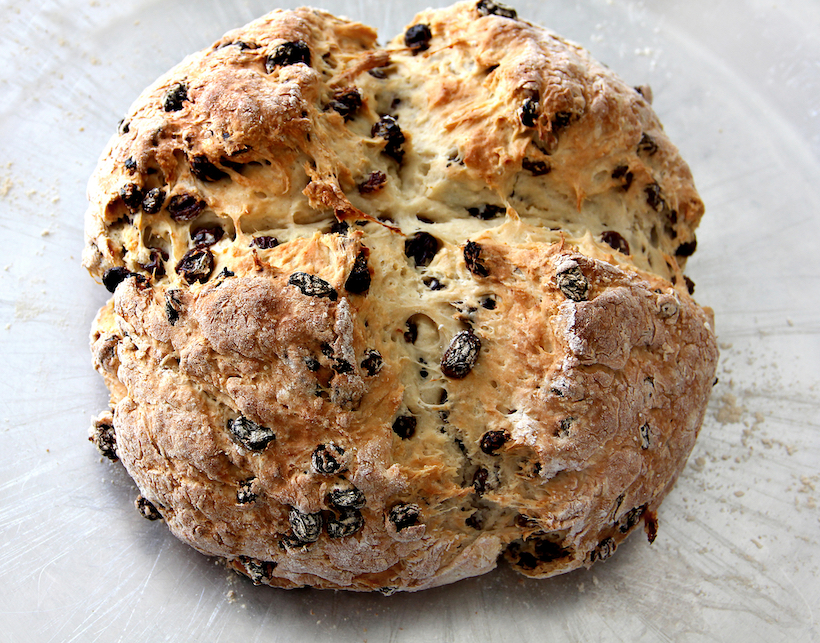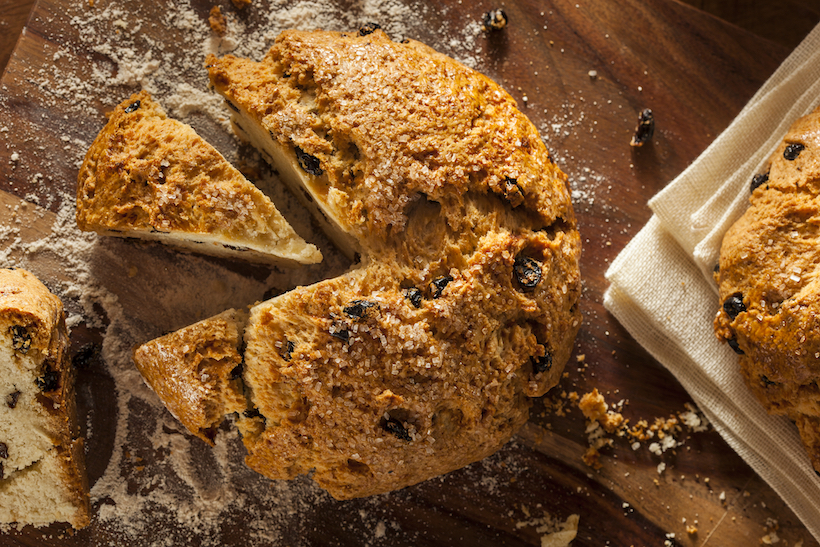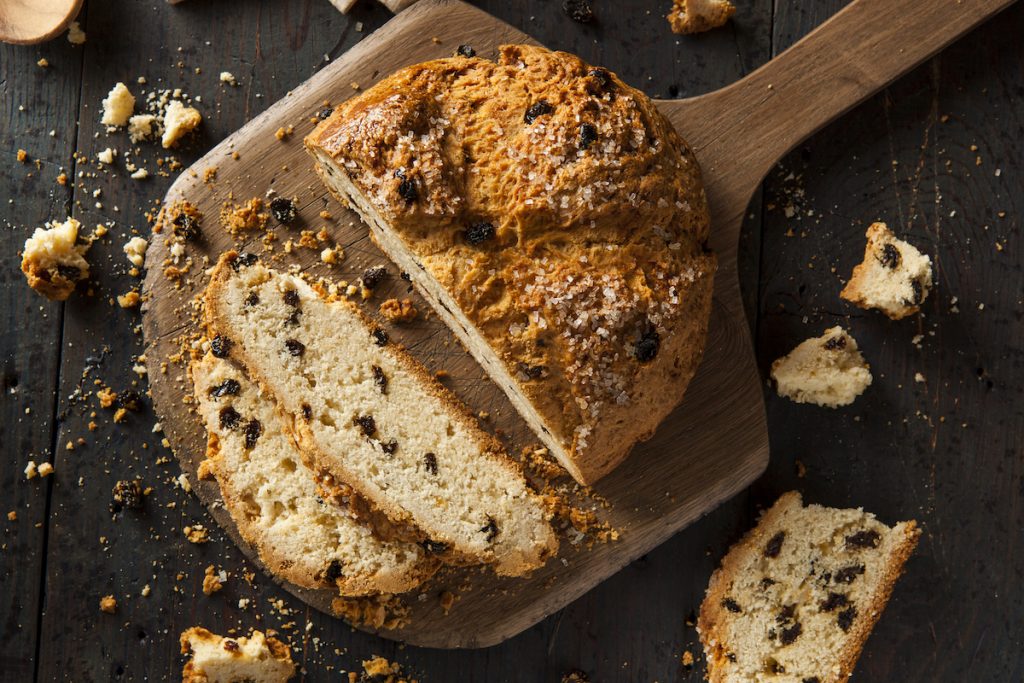Sit down at any traditional Irish restaurant (or, sure, browse their menus online), and you'll find soda bread on the menu—particularly around St. Patrick's Day.
How did this seemingly spartan bread get so ingrained in Irish culture? Let's take a closer look at the history of soda bread and find out.

Soda bread is a type of quick bread leavened with sodium bicarbonate instead of an organic method such as yeast. Although it has a different consistency to typical bread, it still bakes similarly – rising to the form you see on this page.
In modern times, we tend to associate soda bread with the celebration of Irish culture. However, this Irish staple's popularity surged not out of merriment – but out of necessity during the nation's poverty-stricken 1800s because it was so easy to make with the wheat prevalent in Ireland.
An Irish soda bread consists of four simple ingredients: soft wheat flour, salt, baking soda, and acid (usually buttermilk). The bread gets its airy texture from the baking soda and lactic acid reaction, forming small carbon dioxide bubbles within the dough.
Some soda bread purists stick to the bare-bones recipe, but many Irish families and businesses add flair with extras such as:
Regardless of the add-ons, you know you've taken a bite of an Irish soda bread when you feel that bubbly consistency on your tongue.
Depending on which side of the border you're on, Irish soda bread may look a bit different.
In the Republic of Ireland, residents bake round loaves with a cross etched on top, supposedly to protect the household from evil. On the other hand, the Northern Irish cook four triangle-shaped flatbreads called "farls" on a griddle. The name comes from the Gaelic word "fardel," which means "four parts."
The Irish make their soda bread using soft flour because it grows better in the country's mild, moist climate than the hard flour we typically use. Unlike hard flour, low-gluten soft flour doesn't do well with yeast, so quick bread like soda bread is a viable alternative.
Unsurprisingly, a handful of other cultures have their versions of soda bread. In Scotland, for instance, they eat soda farls as well as bannock, an oatcake-like dough fried or cooked on a griddle. And when the British settled in Australia, they began baking a pan loaf called a damper because it was easy to bake in the rugged bushland.

Despite soda bread's association with the Irish, it almost certainly originated elsewhere: North America. Before the nineteenth century, Native Americans cooked flatbreads on hot rocks using potash—a natural soda found in the ashes of wood—as a leavening agent.
In 1824, a recipe for "soda cake" first appeared in The Virginia Housewife, a cookbook by Mary Randolph. It called for sugar, milk, soda, flour, and butter. After kneading the dough until light, Randolph said to bake it in a "brisk oven," indicating the soda cake's quick bread status.
One additional carbonate ion distinguishes sodium bicarbonate—what we call baking soda—from sodium carbonate (soda ash), but that extra ion makes the former much faster acting, giving soda bread its quick rise.
But before the Irish began using baking soda, baking powder arrived on the scene. In 1843, English chemist Alfred Bird used an acid-base reaction to leaven his bread with carbon dioxide bubbles, and he called his invention Alfred Bird's Baking, Pastry, and Cake Powder.
Then in 1846, American Dr. Austin Church and his brother-in-law John Dwight began producing their own sodium bicarbonate in New York City. Previously, Church conducted synthetic sodium bicarbonate experiments in Rochester, NY, and he brought the knowledge he gained with him to NYC.
Together, they founded John Dwight and Company, which later became Church & Co. and even later became the iconic baking soda brand we now know as Arm & Hammer.
How the official baking soda made its way back to Ireland, however, remains a mystery.
After baking soda's introduction to the British Isles, the Irish began making soda bread during the 1830s. The earliest known recipe for making Irish soda bread appeared in the Newry Commercial Telegraph, a Northern Irish newspaper, in 1836: "good wheaten meal, finely-powdered salt, super-carbonate of soda, [and] cold water."
Various publications, including The Farmer's magazine in London and the Journal of the Franklin Institute in Pennsylvania, reprinted this article over the next few years, spreading the word about soda bread.
In addition to its simple recipe, soda bread's lack of cooking equipment needs made it a popular dish for lower-class Irish families who lived in even the most rural areas. Many families even made it every two to three days to eat with their meals. Wives cooked the bread in iron pots over an open fire or on a griddle—slow heat cooking methods that gave soda bread its signature hard crust.
The Irish initially used soured milk for the acid component, which they'd usually buy from the local creamery. As times were getting more challenging financially in the Emerald Isle during the 1840s, using sour milk in this way was a brilliant strategy for repurposing something that would usually have been thrown out.
Today, however, soda bread bakers swap expired milk for buttermilk, which is purposefully cultured to yield a sour taste. Besides being less dangerous to consume, buttermilk is much easier to find.
But back in the 1840s, staving off hunger by any means necessary was the top priority. Starting in 1845, a fungus-like blight called Phytophthora infestans wiped out three-quarters of Ireland's crucial potato crop over the next several years, resulting in the catastrophe known as the Irish Potato Famine.
To avoid starvation, the Irish needed to utilize the most basic and cheapest ingredients available to the best of their ability, including the four needed to make soda bread. Therefore, residents all over Ireland took to using baking soda to make an inexpensive, filling bread they'd eat for years to come.
Even after the potato famine subsided, people continued (and continue!) to find ingenuity in the form of soda bread. In 1916, for example, someone challenged the editor of the English publication Gentleman's Magazine to bake bread using soft wheat. After numerous experiments with his baker, he created a bread using mashed potato and—you guessed it—soda ash.
Today, soda bread lives on as a ubiquitous comfort food both in Irish households and in restaurants. Perhaps soda bread's embodiment of Irish perseverance is why the Irish Diaspora in America has taken to baking it each year when they celebrate their heritage on St. Patrick's Day.
If you plan on partaking in the festivities this year, don't forget to bake yourself a loaf – and check out our bread slicer reviews to cut the perfect slice!

Soda bread isn't anything too complex – four ingredients plus heat, and even the most stubborn soft wheat leaves you with some bread. Yet there's beauty in that simplicity – for many Irish families, it became a staple food right as the potato failed, stemming off some of the blow of the Famine.
So bite in this St. Patrick's Day – you're in good company!